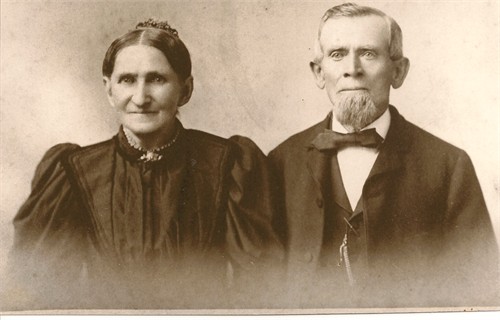We all have those ancestors – you know, the ones who are your continual brick wall. August and Theresa Yess are my brick walls or I should say, ‘were’ my brick walls. My 2nd great grandparents were from what is now Germany, but I couldn’t figure out where exactly or when. Every time I’d start down the path to discover their nativity, they would quickly frustrate me. Then I approached this riddle with a late 19th-century mind and I broke through the wall.
My mom had never heard the names of her great-grandparents before. Her grandfather had died a tragic death overcome by gasses digging a well when her father was 11 months old. No family stories were passed down from him, obviously. Mom found this picture of her great-grandparents after her parents’ death in their attic. It had only their names on the back.

Theresa Hanlach Yess (1824-1910) August Yess (1829-1905)
How do you solve a riddle like this? We didn’t know any of my grandfather’s cousins very well. Mom had never thought to ask them the family stories. So, for over 30 years I simply knew Theresa Hanlach Yess was from Bavaria and August Yess from Prussia. I had checked census records, city directories, probate records, marriage records, death records, obituaries, illustrated histories of Peoria County, Illinois, and other anecdotal information that was available. No more clues than Bavaria and Prussia were available. Yess is a relatively unique last name, much like my married name, Terstriep. I had searched the United States census records and found some in Milwaukee, WI,. but believed my grandparents had come straight from what would become Germany to the Peoria county.
After feeling I had exhausted nearly every clue I had, I spent a vacation day at the local county clerk’s office hoping to find more information. No luck. I finally asked where the local genealogical society was and it was just a few blocks from the courthouse. One quick lunch later, I went into the library and genealogical area to visit with a lady who worked there. She helped me search several sources for more information: funeral home records, church records, cemetery records, etc. No luck.
Then I began thinking like a Prussian and Bavarian immigrant from the 1850s. “Who would care if I died?” I asked myself. I thought about it and decided to check to see if there were any German-language newspapers in Peoria at the time of their deaths. There were at least two – one wasn’t published at the time of their death. The other newspaper, “Täglicher Peoria Demokrat“, was. The lady helping me in the library said she didn’t read German and couldn’t be of much help. I, fortunately, had taken a year of German and could stumble my way through it. German Fraktur font, which most everything was printed in, is not easy to read. Over time I had become a little more comfortable deciphering it while volunteering to transcribe old papers for the Abraham Lincoln Presidential Library and the National Archives and Records Administration.
She politely helped me load the microfilm and carefully explained how to advance on the film. She shared what little knowledge she had of the set up of the paper. As we visited, I forwarded the microfilm to the day after my 2nd great-grandfather’s death and (I know you’re not going to believe this but, ) as if a light shone on it, I saw his name!

Enlarged copy of August Yess’ obituary in the Täglicher Peoria Demokrat, a German-language newspaper of Peoria, IL.

In the orange higlighted box is the original-sized obituary of August Yess. You’ll note the German Fraktur makes the name look like “Auguft Deb” rather than August Yess.
I was so excited I couldn’t believe it! Did it tell where he was born and any other information? I quickly snapped a photo of it, submitted it to the Facebook group I belong where group members translate all languages, and by the time I had made my 1 1/2 hour drive home, I had the answer.
Here is the translation: “August Yeß.
August Yeß, who died in his flat/house, 203 Fischerstraße, yesterday morning, was born in the area of Stettin, Prussia, and came to America in 1852, where he settled at first in Milwaukee. 1855 he came to this area and earned a lot of wealth through a farm. He has been living in Peoria for 15 years. For a short period of time he was ill and his rapid death was very unexpected for his friends and family. He was appreciated in general and was an admired man. He leaves behind a widow and five children. The burial is on Sunday afternoon half 2 o’clock at the house and the Evangelical Trinity church. May he rest in peace!”
Stettin, Prussia? A quick Google Map search told me Stettin, Prussia was today Szczecin, Poland! POLAND! Szczecin is very near the German border. I hadn’t even considered this thought. Today I would be considered part Polish because country’s borders changed so often.
You see, when I thought about it, I considered if I was a Prussian immigrant, most people in the United States wouldn’t really understand the difference between Stettin, Prussia and Berlin, Germany. It wouldn’t make much difference to them what town I was born in, it would make a difference whether or not I was an American or a German. My great-grandfather did become an American before he died, but to his countrymen, they would understand and know the difference. They would care to know exactly what town he was born in. Looking for his obituary in the German-language paper opened that door. Unfortunately, “Täglicher Peoria Demokrat” was not published when my 2nd great-grandmother died. What part of Bavaria she was from is still to be solved.
 Temple Cemetery Quit Claim Deed, Fulton County, IL
Temple Cemetery Quit Claim Deed, Fulton County, IL








